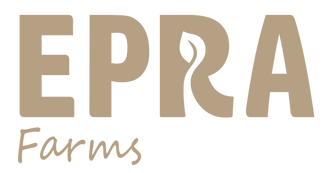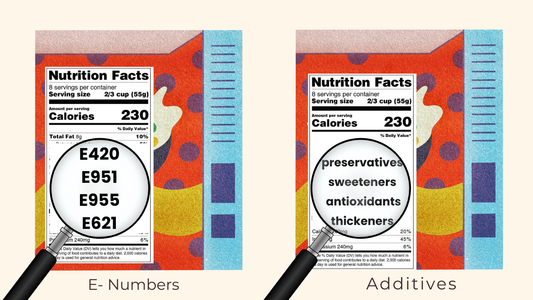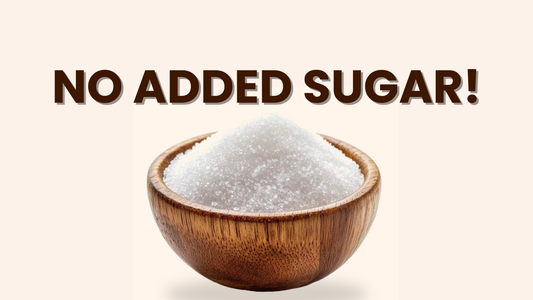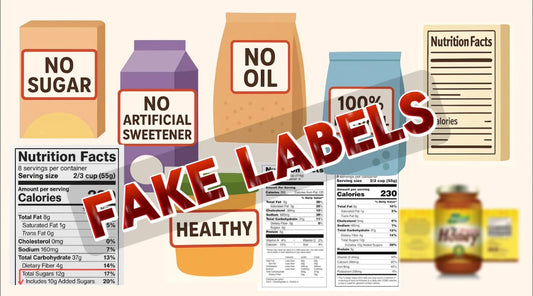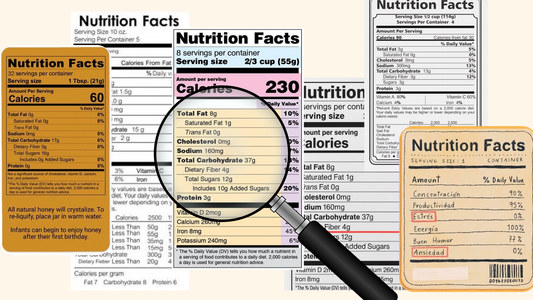Why India Can’t Trust the Front of the Pack
Walk through any supermarket aisle in India today and it looks like a parade of healthy options. Bright cartons and packets jump out at you with claims like:
-
“NO ADDED SUGAR”
-
“MADE WITH REAL FRUIT”
-
“LOW FAT, HIGH FIBER”
-
“DIGESTIVE & HEALTHY”
-
“IMMUNITY BOOSTING”
If you believed every word, you’d think we are living in a golden age of healthy eating. But the reality is darker: these are not promises - they are marketing strategies.
Here’s the simple rule of modern food: the front of the pack is designed for your heart, the back of the pack is designed for your brain.
👉 The front whispers: “Relax, this is good for you.”
👉 The back, if you actually read it, screams: “You’re being fooled.”
This blog is not about demonizing every brand, but about teaching you how to see through the fog. By the end, you’ll be able to pick up any packet - biscuit, juice, health drink, protein bar - and instantly know whether the “healthy” claim is real or fake.
Chapter 1: Why Brands Play the “Healthy” Game
Food companies are not charities. Their job is not to improve your health - their job is to sell more packets. And in today’s India, health sells.
-
Diabetes rates are soaring: India has 100 million diabetics.
-
Parents are worried about junk food in kids’ diets.
-
Young adults want fitness-friendly snacks.
-
Older adults are told to “avoid sugar and oil.”
Instead of reformulating food to truly be healthier, brands choose the cheaper route: reformulate the label.
Marketing Psychology 101
Words trigger emotions.
-
“No Added Sugar” → relief.
-
“Made with Real Fruit” → trust.
-
“Low Fat” → guilt-free.
-
“Organic” → pure and chemical-free.
-
“Immunity Boosting” → protective, especially after COVID-19.
👉 None of these phrases are illegal. But most are misleading when applied to ultra-processed foods.
Chapter 2: The Language of Fake Health
Let’s decode the most common “healthy” phrases that Indian consumers see daily.
1. “No Added Sugar”
Sounds safe, right? But here’s how it works:
-
Instead of adding table sugar, companies use fruit concentrates (which are just concentrated sugar water).
-
Or they use glucose syrup, maltodextrin, invert sugar syrup - all sugars, just renamed.
-
Result: The sugar content is still the same, sometimes worse.
👉 A packaged orange juice with “no added sugar” can have as much sugar as cola.
2. “Made with Real Fruit”
Translation: A few drops of fruit concentrate or pulp added for marketing.
-
Most “fruit drinks” in India contain only 5-10% fruit.
-
The rest = water, sugar, flavoring, stabilizers.
👉 A mango drink claiming “real fruit” might contain less mango than a single slice of actual mango.
3. “Low Fat”
This is one of the biggest global food scams.
-
Fat was demonized in the 1980s. Brands responded with “low-fat” products.
-
But when fat is removed, food tastes bland. To fix this, sugar was added.
-
Result: people ate more sugar, obesity skyrocketed.
👉 A “low-fat yogurt” often has more sugar than a soft drink.
4. “Digestive” or “High Fiber”
Sounds good for your gut, but here’s the trick:
-
A biscuit with 2–3% added bran can legally call itself “digestive.”
-
Sugar still makes up 20–25% of the product.
-
Palm oil and refined flour dominate.
👉 A “digestive biscuit” is closer to a cookie than to dalia.
5. “Organic”
Organic doesn’t mean healthy.
-
Organic jaggery is still sugar.
-
Organic honey is still sugar.
-
Organic cola is still cola.
👉 Don’t confuse “organic” with “nutritious.”
6. “Natural”
This is the most meaningless word in food marketing.
-
Legally, refined sugar can be labeled “natural” because it comes from sugarcane.
-
“Natural flavors” are often lab-processed extracts.
👉 The word “natural” is a shield without substance.
7. “Immunity Boosting”
Post-COVID, this exploded in India.
-
Drinks, biscuits, and even namkeen claim to boost immunity.
-
Usually this means they added vitamin C powder or a dash of tulsi extract.
-
But alongside? 25-30 g sugar per serving.
👉 Sugar weakens immunity. So these products give with one hand, take with the other.
Chapter 3: Case Studies - How Indian Products Fool You
Case Study 1: The Juice Box
Front: “No Added Sugar. Made with Real Fruit.”
Back: Water, fruit concentrate (10%), glucose-fructose syrup.
Sugar per glass: 20–25 g.
👉 Same as a cola.
Case Study 2: The Health Biscuit
Front: “High Fiber. Digestive. No Added Sugar.”
Back: Refined wheat flour, palm oil, invert syrup, jaggery.
Sugar: 22%.
👉 A cookie dressed in Ayurveda clothing.
Case Study 3: The Flavored Yogurt
Front: “Low Fat. Probiotic. Made with Real Fruit.”
Back: Skimmed milk, sugar, fruit puree, flavors.
Sugar per cup: 18–20 g.
👉 More sugar than two teaspoons in chai.
Case Study 4: The Energy Bar
Front: “High Protein. Guilt-Free Snack.”
Back: Oats, sugar, glucose syrup, whey protein, stabilizers.
Sugar: 15–20 g per bar.
👉 A chocolate bar with gym clothes on.
Case Study 5: The Children’s Health Drink
Front: “Boosts Growth. Immunity.”
Back: Maltodextrin, sugar, cocoa solids, vitamins.
Sugar per serving: 12–15 g.
👉 Marketing to parents’ fears, not children’s health.
Chapter 4: Why This Matters
Fake healthy claims aren’t just annoying - they are deadly.
-
India is the diabetes capital of the world.
-
Obesity among kids is rising at record rates.
-
People think they’re making healthier choices, but they’re not.
Every fake label nudges families toward more sugar, more processed calories, and more disease.
Chapter 5: How to Spot the Lies (Practical Guide)
Here’s the cheat sheet:
-
Ignore the front. It’s for your emotions.
-
Flip the pack. Read the ingredient list.
-
Learn the sugar aliases. If you see glucose, syrup, jaggery, maltodextrin, fructose - it’s sugar.
-
Check the nutrition table.
-
<5 g sugar per 100 g = low sugar.
-
10 g sugar per 100 g = high sugar.
-
Don’t be fooled by % of fruit. If it says “contains fruit” but lists concentrate - it’s sugar water.
Chapter 6: Why EPRA Farms Is Different
At EPRA Farms, we believe labels should be transparent, not manipulative.
-
Our monk fruit sweetener is made of only monk fruit + erythritol.
-
No jaggery, no maltodextrin, no hidden syrups.
-
Diabetic-safe, clean-label, scientifically backed.
We’re not here to play the label game. We’re here to build trust.
Chapter 7: The Anatomy of a Food Label
Before we go deeper into case studies, let’s pause and look at the battlefield itself: the food label.
A standard Indian packaged food label has:
-
Front of Pack → Shiny, colorful, full of promises (“Low Fat,” “No Sugar,” “Natural”).
-
Back Panel → Ingredient list + nutrition table.
-
Fine Print → Legal disclaimers, usually ignored.
👉 The trick: 90% of consumers stop at the front. Only 10% flip the pack.
But the truth always hides in the back panel. Let’s decode it section by section.
The Ingredient List
-
By law, ingredients are listed in descending order of weight.
-
If sugar, glucose, syrup, or jaggery are in the top three - the product is sugar-heavy.
-
Example: A “healthy breakfast cereal” → first three ingredients: corn, sugar, glucose syrup.
The Nutrition Table
-
Look at sugars per 100 g, not per serving (because serving sizes are tiny tricks).
-
WHO definition:
-
<5 g sugar per 100 g = low sugar.
-
5–10 g sugar = medium. 10 g sugar = high sugar.
g sugar = high ssugar = high s -
10 g sugar = high
-
Most biscuits, cereals, and drinks are in the 20–40 g per 100 g range.
The Fine Print
-
“No added sugar” may still mean “contains naturally occurring sugars.”
-
“Natural flavors” may be lab-processed extracts.
-
“May contain fruit” can mean less than 1%.
Chapter 8: Indian Case Studies - The Hall of Shame
Let’s dissect real-life examples (categories, not brand names).
1. Fruit Juices & Drinks
-
Claim: “No Added Sugar. Made with Real Fruit.”
-
Reality: 5–10% fruit concentrate + 90% water + flavorings.
-
Sugar load: 20–25 g per glass - equal to cola.
-
Hidden sugar names: fructose syrup, glucose-fructose syrup, maltodextrin.
👉 Translation: sugar water with fruit perfume.
2. Health Biscuits
-
Claim: “Digestive. High Fiber. Good for Digestion.”
-
Reality: Maida, palm oil, invert syrup, jaggery.
-
Sugar load: 20-25%.
-
“Fiber” = 2-3% added bran, just enough to market.
👉 Translation: a cookie wearing khadi.
3. Breakfast Cereals
-
Claim: “Whole Grain. High in Iron & Vitamins.”
-
Reality: Corn + sugar + flavoring.
-
Sugar load: 25-30 g per 100 g.
-
Fortification added at the end to look healthy.
👉 Translation: candy disguised as breakfast.
4. Flavored Yogurts
-
Claim: “Low Fat. Probiotic. Real Fruit.”
-
Reality: Skimmed milk + sugar + fruit puree + flavors.
-
Sugar load: 18–20 g per cup.
-
More sugar than dessert.
👉 Translation: candy in a cup.
5. Health Drinks (Kids’ Category)
-
Claim: “Boosts Growth. Immunity. Stronger Bones.”
-
Reality: Sugar, maltodextrin, cocoa solids, added vitamins.
-
Sugar load: 12–15 g per serving.
👉 Translation: sweetened powder with marketing vitamins.
6. Protein & Energy Bars
-
Claim: “High Protein. Guilt-Free.”
-
Reality: Oats, sugar, glucose syrup, whey, stabilizers.
-
Sugar load: 15–20 g per bar.
👉 Translation: a chocolate bar with gym branding.
7. Ready-to-Drink Teas & Coffees
-
Claim: “Natural Energy. Refreshing.”
-
Reality: Brewed tea + sugar + preservatives.
-
Sugar load: 25–30 g per bottle.
👉 Translation: chilled sugar syrup with a tea label.
Chapter 9: The Indian “Healthy Sugar” Myths
The biggest scam is not cola or candy. It’s the “desi healthy sugar” myths.
Jaggery (Gur)
-
Marketed as: traditional, iron-rich, “better than sugar.”
-
Reality: GI higher than sugar (~84 vs 65).
-
Still raises blood sugar sharply.
-
Iron content? Tiny. You’d need to eat 1 kg of gur for meaningful nutrition.
👉 For diabetics, jaggery is worse than sugar.
Honey
-
Marketed as: natural, ayurvedic, immunity-boosting.
-
Reality: ~80% sugar (glucose + fructose).
-
Calorie-dense (21 kcal per tsp).
-
Raises blood sugar like sugar.
👉 For health, honey = sugar with marketing.
Brown Sugar
-
Marketed as: raw, less processed, mineral-rich.
-
Reality: Almost identical to white sugar.
-
Mineral content negligible.
👉 Brown ≠ better.
Coconut Sugar, Date Syrup, Maple Syrup
-
Marketed as: trendy alternatives.
-
Reality: Slightly lower GI, but still sugar.
👉 A polished scam for health-conscious buyers.
Chapter 10: The Science of Sugar Spikes
Why are added sugars harmful but natural sugars in fruit safe?
-
Fruit sugar package:
-
Fiber → slows absorption.
-
Water → dilutes sugar.
-
Nutrients → balance the impact.
-
Added sugar package:
-
No fiber.
-
Concentrated load.
-
Rapid absorption → spike → insulin surge → crash.
👉 Spike-crash cycle leads to cravings, overeating, insulin resistance, and diabetes.
Chapter 11: The Global Picture
This isn’t just India’s problem.
-
In the US, 74% of packaged foods contain added sugar.
-
Europe regulates front-of-pack claims, but brands still mislead with “organic” and “natural.”
-
WHO recommends <25 g sugar/day - most people consume 3-4x that.
But in India, the problem is sharper:
-
Less awareness.
-
Strong cultural trust in jaggery and honey.
-
Kids’ foods heavily marketed.
Chapter 12: FAQs - Busting Everyday Confusion
Q: Is fruit juice safe if it’s cold-pressed?
A: No. Once fiber is removed, juice behaves like sugar water, even if “cold-pressed.”
Q: Is honey better for diabetics?
A: No. It spikes sugar like table sugar.
Q: Are digestive biscuits healthier than regular biscuits?
A: No. Sugar and palm oil dominate.
Q: Can we trust “low GI” sweeteners like coconut sugar?
A: Not really. They still raise sugar - just a bit slower.
Chapter 13: Label Decoding Hacks
-
If it ends in “-ose” (glucose, sucrose, maltose) → it’s sugar.
-
If it says “syrup” → it’s sugar.
-
If it says “concentrate” → it’s sugar.
-
If jaggery/honey is in top 3 ingredients → it’s sugar.
-
“No added sugar” doesn’t mean “no sugar.”
Chapter 14: Why EPRA Farms Rejects Fake Labels
At EPRA Farms, we believe honesty is the best label.
-
Our monk fruit products don’t hide behind claims.
-
Ingredients: monk fruit + erythritol.
-
No “healthy sugar” myths.
-
No fillers, no marketing gimmicks.
👉 Transparency builds trust.
Chapter 15: The Hidden Names of Sugar
If brands wrote “sugar” openly on the label, most of us would put the pack back on the shelf. So they don’t. Instead, they hide sugar under dozens of aliases.
Here are the most common ones on Indian shelves:
Simple Sugars
-
Glucose
-
Fructose
-
Sucrose
-
Maltose
-
Dextrose
Syrups
-
Invert sugar syrup
-
High fructose corn syrup (HFCS)
-
Rice syrup
-
Corn syrup solids
-
Malt syrup
-
Golden syrup
“Healthy” Sugars
-
Jaggery
-
Brown sugar
-
Honey
-
Coconut sugar
-
Date syrup
-
Fruit juice concentrate
Sugar Alcohols (not harmful, but misleading)
-
Sorbitol
-
Mannitol
-
Maltitol
-
Xylitol
👉 Rule of thumb: if it ends with “-ose” or is called a “syrup” → it’s sugar.
Chapter 16: How Sugar Hides in “Healthy” Indian Products
Example 1: Kids’ Biscuits
-
Label says: “No added sugar, fortified with iron.”
-
Ingredient list: glucose syrup, fruit concentrate, jaggery.
-
Reality: Still 20–25% sugar.
Example 2: Sports Drinks
-
Label says: “Electrolytes for hydration.”
-
Ingredients: water, sucrose, glucose-fructose syrup.
-
Reality: 30 g sugar per bottle.
Example 3: Protein Shakes
-
Label says: “High protein. Muscle fuel.”
-
Ingredients: whey protein + sucrose + stabilizers.
-
Reality: More sugar than protein in many brands.
Chapter 17: The Sugar-Health Connection
Why does this matter? Because fake healthy claims are not just marketing tricks - they shape health outcomes.
-
Diabetes: Added sugar accelerates insulin resistance.
-
Obesity: Hidden sugar = calorie surplus.
-
Fatty liver: Fructose overload in drinks → liver fat.
-
Heart disease: Sugar raises triglycerides, lowers HDL (“good cholesterol”).
-
Brain health: Sugar addiction changes dopamine pathways; long-term links to Alzheimer’s.
👉 Fake healthy claims = lifestyle diseases packaged in shiny wrappers.
Chapter 18: Why Natural Sugars Aren’t the Enemy
It’s important not to overcorrect. Many people, scared of “sugar,” avoid fruits. That’s a mistake.
-
Fruit sugar comes with fiber, vitamins, minerals, antioxidants.
-
Milk sugar (lactose) comes with protein, calcium, vitamin D.
-
These sugars are absorbed slowly, not spiking blood sugar in the same way.
👉 The problem isn’t sugar in fruit. It’s sugar in biscuits, drinks, and snacks.
Chapter 19: Global Regulations vs India
-
Europe: Strict front-of-pack labelling (“High sugar,” “Low sugar”).
-
USA: “Added sugars” must be listed separately in grams.
-
India (FSSAI): Rules exist but loopholes remain. “No added sugar” doesn’t stop use of concentrates. “Natural” isn’t clearly defined.
👉 Indian consumers are more vulnerable because labeling laws are weaker and marketing is stronger.
Chapter 20: Why We Fall for These Claims
-
Trust in tradition: Jaggery, honey = Ayurvedic halo.
-
Scientific jargon: “Low GI,” “fortified,” “digestive.”
-
Parental guilt: “Healthy growth for kids.”
-
Fitness obsession: “High protein,” “low fat.”
-
Post-COVID fear: “Immunity boosting.”
👉 Brands exploit our psychology, not our biology.
Chapter 21: The Addiction Problem
Sugar isn’t just sweet - it’s addictive.
-
It activates dopamine in the brain.
-
Creates cravings and withdrawal symptoms.
-
“Healthy claims” trick you into consuming more sugar, guilt-free.
👉 That’s why “no added sugar” biscuits are so dangerous: you eat more, thinking they’re safe.
Chapter 22: Practical Tools to Outsmart Labels
Here’s your label decoding checklist:
-
Ignore the front. Flip the pack.
-
Look at the first 3 ingredients.
-
If sugar, jaggery, honey, or syrup appear early → it’s high sugar.
-
Check “per 100 g” sugar. If >10 g, it’s unhealthy.
-
Learn the aliases.
-
If a claim sounds too good, assume it’s marketing.
Chapter 23: FAQs
Q: Is jaggery better than sugar?
A: No. Slightly more minerals, but still raises sugar faster than white sugar.
Q: Are energy drinks safe if I exercise?
A: Most are just sugar water. Electrolytes don’t cancel sugar.
Q: Is honey safe for diabetics?
A: No. It spikes blood sugar the same way.
Q: What about “sugar-free” biscuits?
A: They often use maltitol or sucralose + hidden carbs. Not really free.
Q: Which sweetener is safest?
A: Monk fruit (zero GI, natural, no aftertaste).
Chapter 24: The EPRA Farms Difference
We don’t hide behind fake healthy claims.
-
Our monk fruit products list exactly what’s inside
-
No jaggery, no concentrates, no “healthy sugar” myths.
-
Just monk fruit + erythritol - clean, natural, safe.
👉 We don’t just sell a product. We sell trust and education.
Chapter 25: Final Takeaway
Fake “healthy” claims are not mistakes - they are strategies. They keep India addicted to sugar while pretending to protect health.
From “no added sugar” juices to “digestive biscuits” to “immunity-boosting drinks,” the pattern is the same: replace truth with marketing.
👉 But once you learn to read labels, the trick is over. You see the pattern, you understand the lies, and you choose better.
And in India, choosing better isn’t just about weight - it’s about survival in the face of diabetes, heart disease, and obesity.
The future belongs to clean labels and honest food. That’s why EPRA Farms stands where it does: bringing monk fruit, the cleanest sweetener, into Indian homes.
